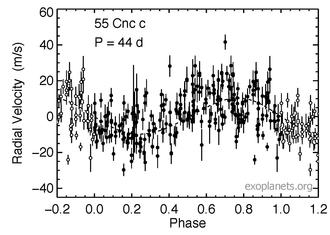Brahe (exoplanet)
|
Exoplanet Brahe |
|
|---|---|
| Artist's impression | |
| Constellation | cancer |
| Position equinox : J2000.0 |
|
| Right ascension | 08h 52m 35.81093s |
| declination | + 28 ° 19 ′ 50.9511 ″ |
| Orbit data | |
| Central star | Copernicus A |
| Major semi-axis | 0.23735 ± 0.00024 AU |
| eccentricity | 0.072 +0.013−0.014 |
| Period of circulation | 44.373 +0.02−0.018 d |
| Further data | |
| Dimensions | 0.1784 +0.0275−0.0078 M J |
| distance | 12.5 pc |
| method | Radial velocity method |
| history | |
| discovery | GW Marcy et al. |
| Date of discovery | 2002 |
| Catalog names | |
| 55 Cancri c, HD 75732 c | |
Brahe ( 55 Cancri c ) is an extrasolar planet orbiting component A of the binary system Copernicus (Flamsteed designation: 55 Cancri A / B). Due to its high mass , it is believed to be a gas planet . Seen from its star , it is the third known planet in its planetary system .
discovery
Brahe was discovered using the radial velocity method after evaluating observational data collected from 1989 to 2002 at the Lick Observatory . At the time of discovery, it was already known that Copernicus had a planet, namely Galileo . Brahe and Lipperhey were published by Geoffrey Marcy and R. Paul Butler in June 2002. At first there was still a doubt as to whether it really was a planet, since the star has a very similar rotation period of 42 days, which could simulate a planet with this orbital period. These doubts could be dispelled by further observations, so that Brahe is considered confirmed.
Track properties
According to the model with five large planets in orbit around Copernicus A, the planet has an only slightly eccentric orbit of 0.086. It may have a 1: 3 orbital resonance with the planet Galileo further inside . One cycle is completed every 44.34 earth days . The planet orbits its star at a mean distance ( major semi-axis ) of about 0.24 astronomical units . It is closer to it than Mercury is to the sun.
Physical Properties
Brahe has a minimum mass of 0.169 Jupiter masses or almost 54 earth masses . With the currently assumed system inclination of 53 °, which has yet to be confirmed, it would be significantly more massive at 0.21 Jupiter's masses. A gas planet without a solid surface is assumed.
Origin of name
Like all exoplanets, Brahe was originally designated with the star's official name and a lowercase letter, according to the order in which it was discovered. After a publicly advertised competition by the International Astronomical Union (IAU), it was officially named on December 15, 2015 after the Danish astronomer Tycho Brahe .
swell
- GW Marcy et al .: A planet at 5 AU Around 55 Cancri. The Astrophysical Journal, 581 (2002): 1375-1388. Doi : 10.1086 / 344298

